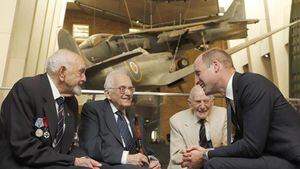William shares memories of Nazi camp visit with Holocaust survivor
The Duke of Cambridge met Freddie Knoller who lived through periods in a series of concentration camps including Auschwitz.

The Duke of Cambridge has told a Holocaust survivor that his recent trip to a concentration camp was an eye-opening and sobering experience.
William described his feelings following the visit when he met former French Resistance fighter Freddie Knoller, 96, who lived through periods in a series of concentration camps including Auschwitz.
The men met at London’s Imperial War Museum where the Duke, who is president of the institution’s Foundation, was brought up to date about the second phase of a £33.5 project to enhance the attraction’s visitor experience.
In July the Duke and his wife were taken on a guided tour of Stutthof, a former Nazi-run camp built in what is now Poland, where 65,000 people, including 28,000 members of the Jewish community, died before it was liberated by the Allies in May 1945.
After Mr Knoller presented William with a copy of his book, Living With The Enemy, about his war experiences, the Duke said: “Catherine and I were in Poland earlier this year, we had a very eye-opening tour around the camp – it was very eye-opening, very sobering.”
Mr Knoller showed William a badge that he used to stay alive in early 1945 while on a death march from Auschwitz.
He replaced his yellow star – a Nazi identification for Jews – with a red triangle badge from the uniform of a dead French prisoner which allowed him to survive internment at the Dora concentration camp, where he was used as slave labour.
He ended up in Bergen-Belsen, where he was liberated by the British.
William looked at the badge, which now forms part of the museum’s exhibition, and asked, “How did you get it off – you tore it off?”, and was told he did.
Mr Knoller said afterwards: ‘I showed him my striped uniform. This saved my life because it doesn’t show the number of a Jew, but of a French political prisoner.
“When I put it on, they thought I was a French political prisoner. It saved my life. I don’t want the world ever to forget what happened during the Second World War.
“I don’t want the world to forget that six million Jews were murdered by the Nazis. This is why I tell the story.”





